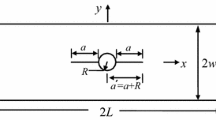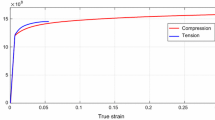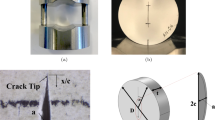Abstract
A theoretical analysis of stress intensity factors and crack opening displacements for the double cleavage drilled compression specimen (DCDC) is presented. This specimen exploits a well known fact that the stress field around a circular hole in a plate subjected to uniaxial stress reverses sign at points on the hole which are parallel to the applied stress. Under uniaxial compression, tensile stresses exist at the edge of the hole and this tensile stress propagates a crack in the DCDC specimen. Because this tensile region is very localized, catastrophic crack growth cannot occur and it is not necessary to groove the specimen to promote straight crack growth. The controlled crack growth possible with this specimen should make it possible to examine fracture mechanisms in detail. The simplicity of this test specimen also makes it an ideal candidate for studying environmental effects on fracture.
Résumé
On présente une analyse théorique des facteurs d'intensité de contraintes et des déplacements d'ouverture de fissure pour une éprouvette donnée de compression à double clivage (DCDC). Ce type d'éprouvette exploite le fait bien connu que le champ de contraintes autour d'un trou circulaire dans une plaque soumise à contraintes uniaxiale change de signe dans les zones du trou parallèle à la tension appliquée. Sous compression uniaxiale, des tensions existent au bord du trou et ces tensions induisent la propagation d'une fissure dans l'éprouvette DCDC. Comme la zone concernée est trés localisée, il ne peut survenir de croissance catastrophique de la fissure, et il n'est pas nécessaire d'entailler l'éprouvette en vue de provoquer une propagation droite de la fissure. Le fait de pouvoir contrôler la croissance de la fissure dans ce type d'éprouvette devrait rendre possible l'examen en détail des mécanismes de rupture. La simplicité de cette éprouvette d'essai en fait également une candidate idéale pour l'étude de effets de l'environnement sur la rupture.
Similar content being viewed by others
References
C. Janssen, in Proceedings Xth International Congress on Glass, Kyoto, Japan (1974) 23.
C. Janssen, “Fracture characteristics of the DCDC specimen,” Report No. R-8074, Corning Glass Works, Corning, NY (1980).
R.C.J. Howland, Transactions Royal Society (London) A, 229 (1930) 49.
R.C.J. Howland and A.C. Stevenson, Transactions Royal Society (London) A, 232 (1933) 155.
H. Hengst, ZAMM 18 (1938) 44.
C.K. Wang, Journal of Applied Mechanics (Transactions ASME) 13 (1946) A-77.
W.T. Koiter, Quarterly of Applied Mathematics 15 (1957) 303.
D. Shilkrut and E. Ben-Gad, Journal of Applied Mechanics (Transactions ASME) 52 (A85) 216.
R. Tiffen, Quarterly Journal of Mechanics and Applied Mathematics 6 (1953) 344.
G.G. Adams, International Journal of Engineering Science 18 (1980) 455.
P.S. Theocaris and N.I. Ioakimidis, Quarterly of Applied Mathematics 35 (1977) 173.
A.S. Argon and M. Salama, Materials Science and Engineering 23 (1976) 219.
A.S. Argon and M. Salama, Philosophical Magazine 36 (1977) 1217.
A. Chudnovsky, I. Palley and E. Baer, Journal of Materials Science 16 (1981) 35.
N.I. Muskhelishvili, Some Basic Problems of the Mathematical Theory of Elasticity, 3rd. Ed., Noordhoff, Gronengen (1953).
C.G. Sammis and M.F. Ashby, Acta Mettalurgica 34 (1986) 511.
T.A. Michalske and E.R. FullerJr., Journal of the American Ceramic Society 68 (1985) 586.
Author information
Authors and Affiliations
Rights and permissions
About this article
Cite this article
Warren, W.E. Theoretical analysis of the double cleavage drilled compression specimen. Int J Fract 33, 223–235 (1987). https://doi.org/10.1007/BF00013172
Received:
Accepted:
Issue Date:
DOI: https://doi.org/10.1007/BF00013172




